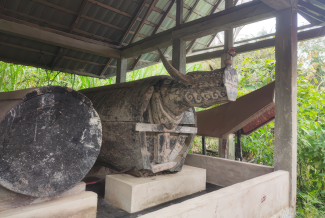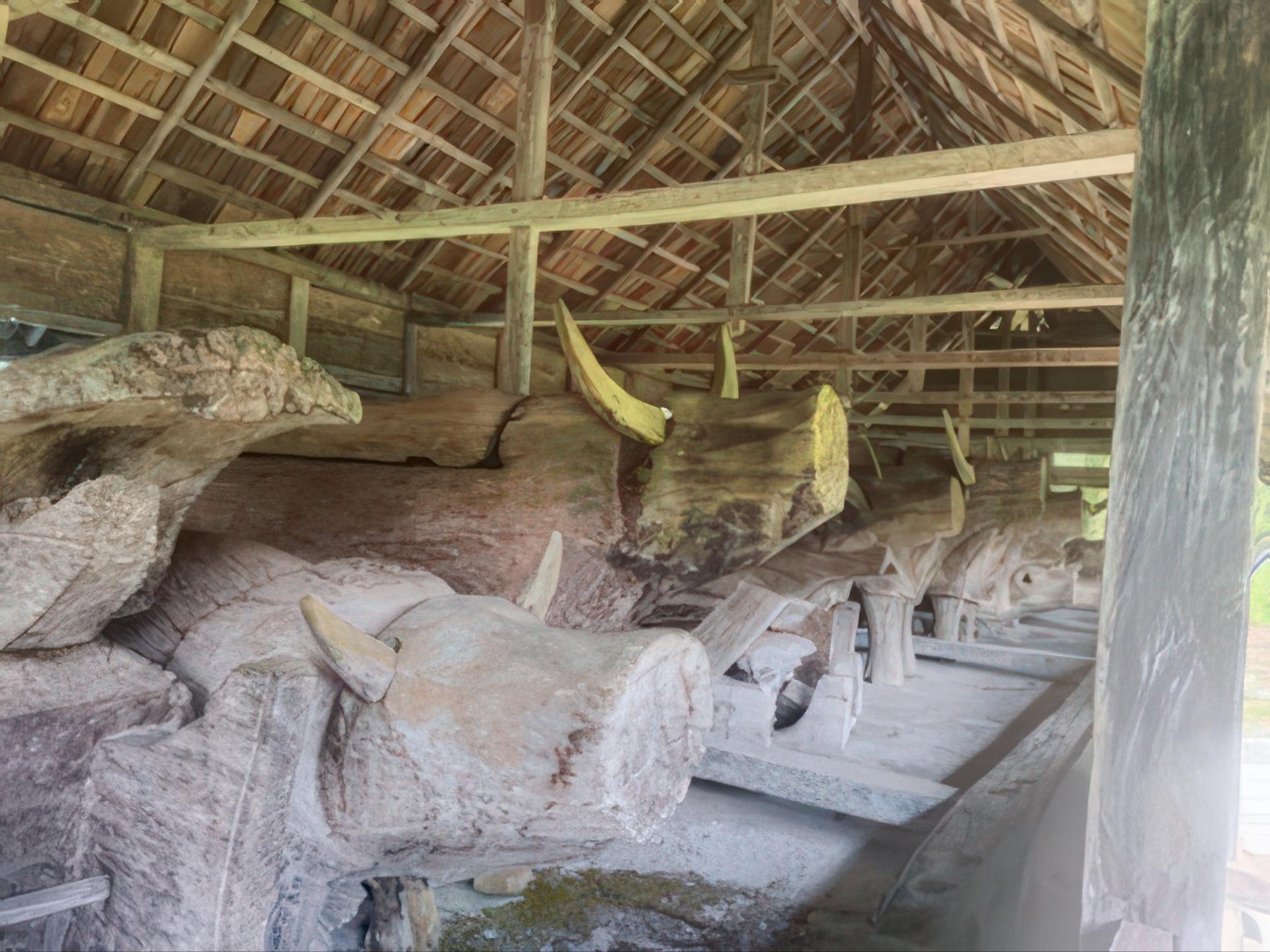
In 2025, the Aliansi Masyarakat Adat Nusantara Pengurus Daerah Pitu Uluna Salu Kondo Sapata’ Wai Sapalelean received a Keepers of the Earth Fund grant to support their work to revitalize their culture through teaching and documentation of their language, arts, and rituals. Their work also includes mapping their territory to protect forests and restoration of ancient tedong-tedong burial sites, which are fundamental in their spirituality.
The tedong (buffalo) holds immense cultural and spiritual significance for the Mamasa Peoples, symbolizing strength, prosperity, and high social standing. It is a central figure in many traditional ceremonies, particularly rambu solo (funerals). By carving a tomb in the shape of a buffalo, the community honors the deceased’s influence and social status, reinforcing their legacy in the afterlife. In Toraja custom, tombs are more than places of rest; they are symbolic vehicles to the after- life. These tombs may take the form of various animals or objects, each with its own cultural meaning. One of the most iconic and widespread forms is the buffalo- shaped tomb, known as tedong-tedong.
The story of tedong-tedong is more than a reflection of the Mamasa Peoples’ artistic and spiritual legacy: it is a living testament to the enduring relationship between a people and their ancestors. These sacred wooden tombs are vessels of memory, identity, and belief, carved from ancient trees and a deep-rooted wisdom passed down through generations. As the forces of time, climate, and modernization threaten to erode this tradition, the Mamasa Peoples stand at a crossroads. At stake is not merely the survival of a funerary custom, but the preservation of a worldview that places harmony with nature, respect for Elders, and communal responsibility at its center.

Banua (Mamasa traditional house).
Land of Seven Riverheads
Pitu Uluna Salu Kondo Sapata’ Wai Sapalelean is our official Tribal name. It is often shortened to Kondo Sapata’ or Mamasa, and while these terms are sometimes used interchangeably, it is important to note that Mamasa is the name of just one of the many Tribes that make up the Kondo Sapata’ Indigenous Nation. Kondo Sapata’ has long inhabited the highlands of what is now known as West Sulawesi, Indonesia. According to our tulasan or tula’ tomatua (ancestral oral traditions), the first to arrive and establish civilization in this land was Nene’ Pongkapadang, who came from Sa’dan Toraja. Outsiders often distinguish us from the broader Toraja Indigenous Nation, but we recognize and acknowledge ourselves as part of that larger cultural and spiritual kinship.
People living in the central Toraja regions often refer to us as Toraja Barat, or West Toraja. In English, Pitu Uluna Salu Kondo Sapata’ Wai Sapalelean means “Land of Seven Riverheads with One Embankment in a Vast Rice Field.” Our community originally consisted of seven major traditional groups. Over time, these expanded in a cultural process known in the Mamasa language as Di Tawa Pole Mana, eventually forming the 25 traditional communities that today span across Mamasa Regency. We are an Indigenous federation of communities, each governing itself through its own adat (customary law) while remaining united under a shared responsibility to protect and steward the ancestral lands of Kondo Sapata’. Despite our diversity, we are bound by mutual respect, a deep relationship with nature, and shared values. Each community upholds its unique customs and laws, yet all recognize the unifying principle of Ada’ Tuo, our most trusted and effective guide for resolving conflicts and sustaining communal harmony.
Tedong-tedong embodies the spiritual beliefs of the Mamasa Peoples, particularly their connection with ancestral spirits. These spirits continue to watch over and guide the living. The tedong-tedong serve as a spiritual home for the ancestors, a sacred space where their presence remains active. The practice of tedong-tedong burial is inextricably linked to the tongkonan (clan) system of the people. People in the same tongkonan share one tedong-tedong, so the number of skeletons in each tedong-tedong sometimes reaches into the hundreds. The diameter of the tedong-tedong can reach up to two meters and is made from Uru wood, which is now increasingly rare. Skilled artisans who inherit the craftsmanship through generations carve these wooden tombs, a process that can take months depending on the size and complexity of the carvings.
Tedong-tedong are not buried underground. Instead, they are placed in sacred locations such as rock caves or traditional burial sites called Liang. Some are adorned with intricate carvings that depict the life story of the deceased and ancestral legends passed down through generations. Tedong-tedong tombs are increasingly under threat, particularly from environmental degradation, loss of Traditional Knowledge, and climate change.
Traditionally, many tedong-tedong are placed near rivers or water sources, reflecting the Mamasa Peoples’ deep connection to nature and the belief in water as a spiritual conduit. However, increased rainfall, intensified weather patterns, and riverbank erosion have begun to endanger these sacred tombs. Heavy rains lead to landslides and flooding, gradually weakening the ground beneath the tombs. The once-stable terrain now suffers from soil instability, causing many tedong-tedong to collapse, tilt, or be swept away entirely. The organic nature of the mate- rials makes them particularly vulnerable to rot, mold, and decay in increasingly humid and erratic weather conditions.

Some of the tedong-tedong are decorated with typical Mamasa carvings.
Efforts have been made by Indigenous communities to protect and conserve these ancestral legacies through building protective roofs, reinforcing the surrounding soil, and creating drainage systems. These actions are not simple engineering tasks—they are sacred responsibilities. Any intervention must go through strict customary protocols, beginning with the mabulang messita ritual, a ceremonial act to seek spiritual permission. Before any physical work is carried out, there must be a kombongan kalua (great assembly) of adat (Elders) from the tongkonan to deliberate and approve the preservation efforts. These rituals ensure the community’s spiritual safety while reaffirming the sacredness of the site and the people’s continued commitment to ancestral values.
Compounding the environmental threats is the historical trauma of cultural looting and vandalism. During the mid-20th century, during the Darul Islam/Tentara Islam Indonesia rebellion, numerous tedong-tedong tombs were looted. Many precious heirlooms, ceremonial jewelry, and spiritual objects were taken and sold on black markets, resulting not just in a material loss, but a deep spiritual wound for the
communities. In recent years, there have been rare, but significant, cases where artifacts resurface serendipitously, found by farmers while tending to their fields. These discoveries are treated with great care. After appropriate rituals, such items are ritually returned to their
original tombs or guardians, demonstrating the enduring resilience of Mamasa Peoples’ customary values.
Despite these restoration efforts, the number of artisans capable of crafting tedong-tedong is declining. With youth migrating to cities and modern professions, the transmission of this specialized knowledge has been disrupted, and the loss of skilled carvers, ritual experts, and
tong-konan leaders threatens the continuity of the practice.
Today, the Mamasa People are navigating a delicate balance of protecting sacred traditions while responding to rapidly changing environmental and social conditions. Preserving the tedong-tedong tombs is not just about saving wooden structures; it is about defending an entire worldview, one where the past, present, and future are spiritually and communally interwoven. Safeguarding tedong-tedong means more than physical preservation. It means honoring the ancestral covenant, supporting the artisans and Elders who still hold this knowledge, and inviting younger generations to reconnect with their roots. It also calls on the broader public, researchers, policymakers, and cultural institutions to stand in solidarity with Indigenous communities like Kondo Sapata’ to ensure their stories are not silenced or forgotten.
Taufik Rama Wijaya (Mala’bo’) belongs to the Pitu Uluna Salu Kondo Sapata Wai Sapalelean Indigenous Federation, an organization of Mamasa Peoples.
Top photo: The tedong-tedong tradition is a cultural heritage of the Indigenous Mamasa Peoples in West Sulawesi, Indonesia. While the Mamasa and Toraja regions are geographically close, they each have distinct cultural identities.
All photos by Taufik Rama Wijaya.
